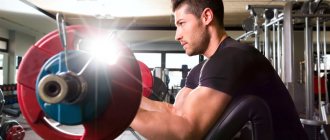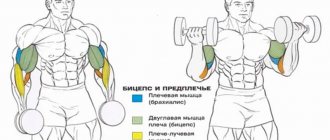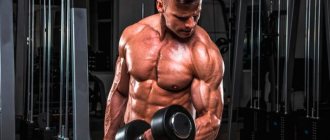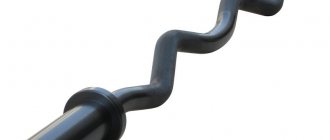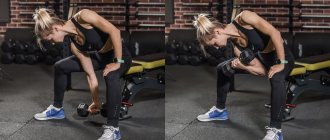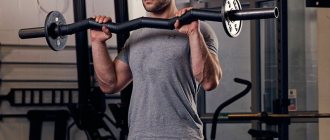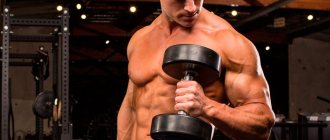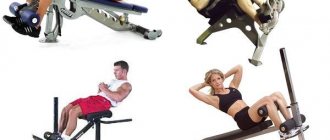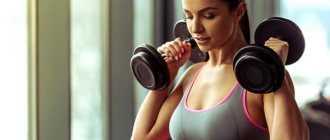Concentrated biceps curls can be seen quite often in the gym. There is an opinion that it is he who helps pump the biceps muscle to its peaks. But the scientific possibility of “appearance” of peaks on the hand of a person who is not genetically predisposed to this has not yet been proven. However, the exercise is popular. It allows you to use light to medium weights and work both biceps symmetrically.
What muscles does the concentrated biceps curl work?
From the very name of the exercise, concentrated biceps curl, we can understand which muscle is being emphasized.
We are talking about the biceps brachii muscle.
Most people call it biceps, but the essence does not change.
This muscle has 2 heads:
- Short. Which is located closer to the body. And despite the name, this head is larger in size. And the short one is the tendon.
- Long. It bears most of the load. After all, when he puts his elbow forward, this head is in the most extended position. Therefore, contraction in it occurs at full amplitude. But the short one, on the contrary, with this position of the elbow shrinks a little.
This is the main muscle group for the development of which we perform this exercise. But since we are bending the elbow joint, it means that two more muscles will be involved in any case. Such as:
- Brachialis. A small muscle located under the biceps. Together with him, he bends his arm at the elbow joint. Most involved in the initial phase of the movement.
- Brachioradialis. Or as it is also called, the brachioradialis muscle. It belongs to the muscles of the forearm. But it is also involved in elbow flexion and hand supination (rotation towards the thumb).
And of course there are muscles that stabilize our arm and shoulder. This:
- Triceps. Or the triceps muscle, the back of the arm.
- Deltoid muscles. These are the same muscles that most people mistakenly call shoulders.
As you can see, even though the exercise is isolated, the body still uses a large set of muscles to perform it.
What does the exercise do?
First of all, it’s worth understanding what the purpose of this exercise is and which muscles are most used by concentrated arm curls.
- The biceps muscle, that is, the biceps. This is the target muscle that does almost all the work of lifting the dumbbell. An isolated load contributes to the formation of a voluminous biceps peak; both heads are worked out at once.
- Brachialis muscle or brachialis.
- Brachioradialis muscle or brachioradialis.
Muscle work during exercise.
Thus, the exercise develops the biceps and forearm. In the case where the athlete’s goal is comprehensive arm training, and not just the development of the biceps muscle, it must be supplemented with other exercises. Such training will make your body harmonious and beautiful.
Concentrated arm curls are recommended for athletes with an average level of fitness and above. It is best to do it at the end of an arm workout. In other words, you should first warm up, and then do, for example, dumbbell or barbell curls, and after that you can start doing curls.
It is recommended to do 3-4 sets of 8-12 repetitions. When choosing the optimal weight, focus on your level of physical fitness. For beginners, it is better to use dumbbells weighing 5-10 kg. In the future, you can gradually increase the weight. In any case, the weight you use for isolation exercises should be lower than for compound exercises.
Remember that the main key to the effectiveness of an exercise is the correct technique for performing it.
Advantages and disadvantages of this exercise
Before we begin to analyze the technique and variations of this exercise. It wouldn’t hurt to talk about why we should do it at all. And there are several reasons for this:
Advantages
- Concentrated biceps curls are aimed at working the long head of the biceps. And if the talk about the effect of exercise on peak fitness is true, then that's a plus for us.
- The biceps work at the maximum available amplitude. No other exercise can achieve this.
- You don't need a lot of training equipment. What makes the exercise generally accessible in any gym. And if you wish, you can do it at home.
- The ability to work on each hand separately. This will have an extremely positive effect on the development of the biceps and reduces the imbalance of strength and form between the two sides.
- Excludes any assistance from other muscles. Of course, there is an option to help with a second hand. But on the contrary, it will help you complete the exercise to complete failure.
For me, this is a sufficient number of advantages for the exercise to be included in your training program. But before that, you should know about some disadvantages. Of course, they are not so significant, but you should still know about them.
Flaws
- The exercise is isolated, so the weight of the burden will be much less than in regular ARM BENDS WITH DUMBBELLS. This means that by performing these lifts we will not be able to increase the mass of the biceps.
- Since the movement is performed by each hand separately. Therefore, it takes twice as long to complete it. If you don’t have enough of this resource, you’ll have to choose other exercises.
- Not suitable for beginners. Since the presence of muscle mass in the arm is required.
Exercises with an expander for women at home
The complex for women using a tool is aimed at toning muscles and reducing excess weight. Let's look at exercises with an expander to work different muscle groups.
Chest exercises
During training, you need to drink enough water and monitor your breathing evenly. Consider a complex with a chest expander:
- Stretching the spring with straight arms. For the exercise, use a tape or chest apparatus. The exercise is performed in a standing position with a straight back. The simulator is fixed in both hands in front of you. The spring of the expander is stretched until the arms are fully straightened. For women starting training, 8 repetitions will be enough. Advanced athletes need to perform the load over 15 times.
- Torso turns with an expander. Take the starting position, as in the previous exercise, and extend your arms in front of you with the ends of the projectile secured. The left arm is bent at the elbow, and the body is turned towards the working limb. The right hand is kept static. The exercise simulates pulling a bow string. The number of repetitions of the exercise for each side is 8-10 times.
- Stretching your arms upward with an expander. Starting position, as in exercises 1 and 2. The springs are placed on the back and both ends are secured in the palms. The hands make sideways and downward movements, as if a woman is trying to throw a blanket over herself. Similar actions are repeated 15 times at a slow pace. The main rule when performing the exercise is to avoid bending your elbows.
For the back
Exercises using an expander are prescribed for the prevention of diseases of the musculoskeletal system and for a speedy recovery after injuries and surgical interventions:
- Thrust to the belt in a sitting position. They sit on the floor, bringing their legs together. The handles of the tape device are held in the palms in front of you. As you inhale, straighten your back and move your elbows back so that your shoulder blades come together. As you exhale, take the starting position. The number of repetitions of the exercise is 10-15 times.
- Rows with a load on the back. They get to their feet, throw the tape over the horizontal bar, and secure the ends of the projectile in their hands. As you inhale, pull your elbows back (as in exercise 1). In this position, the body is fixed for 2-3 seconds, then returned to the starting position.
- Raising your arms while sitting on a chair. They sit on a chair with a back, pressing their feet to the floor, and throw the expander tape over the back of the furniture. The ends of the projectile are fixed in the palms. As you inhale, pull the expander handles up (above forehead level) with straight arms. Number of repetitions – 10-12 times.
For hands
The set of exercises with an expander differs for women prepared for training and for beginners. In the latter case, resort to the following types of load:
- Rotation of the hands with simultaneous squeezing of the wrist expander. It is desirable that the projectile has a small drag force.
- Squeezing the exercise machine in your hand. A rubber ball or ring is squeezed in the hand to the limit, and then the hand is relaxed. The number of repetitions for beginners does not exceed 15 times.
- Long-term compression of a rubber projectile. The device is held in a compressed position for 15 seconds, and then the arm muscles are relaxed. The number of repetitions is 2-3 times, the break between each approach is 20-30 minutes.
Trained women can use the above complex as a warm-up. Then it is supplemented with other, more complex exercises:
- prolonged compression of the projectile (up to 1 minute);
- periodically squeezing the rubber ball for 1.5 minutes;
- compression of the expander with a high resistance index 10 times.
For the buttocks
To work out the buttocks and legs, it is best for women to use a tape-type expander. Let's take a closer look at the complex suitable for ladies:
- Raising the lower limbs while lying on your side. One end is fixed in the hand, and the upper leg is inserted through the second handle. As you inhale, slowly lift it up without bending your knees, and hold it at the top point for 5-6 seconds. The number of repetitions for each leg is 10 times.
- Extending your legs to the sides. Hands hold one end of the loop, and the active leg is inserted into the other handle. The active limb is slowly retracted while inhaling and lowered to the starting position at the same pace. The number of repetitions for each side is 15 times.
- Taking the leg back. The exercise technique is the same as in point 2, only each limb is pulled back slowly.
- Leg raises on a chair using a butterfly expander. The device is placed between the thighs and then the knees are slowly brought together. After this, the simulator is unclenched and returned to its original position. Number of repetitions – 10 times.
Exercise technique (classic version)
To begin with, we will look at the classic sitting option, which is the most popular. To perform it we will need a dumbbell and a bench press.
Initial position:
- Place the bench press in a horizontal position.
- Take a dumbbell in one of your hands and sit on a bench. Spread your legs to the sides.
- Lean your body forward slightly. Place the palm of your free hand on the thigh of the same leg. We lower the hand with the dumbbell down so that it is perpendicular to the floor. And we rest the area just above the elbow on the inner thigh of the leg.
We will begin the exercise from this position.
Performance:
- As you exhale, begin to bend your arm at the elbow. Thus, we raise the dumbbell up, as close as possible to the opposite shoulder. At the top point, press the dumbbell until you feel the peak contraction of the biceps
- Then, as you exhale, slowly and under control, extend your arm and return to the starting position.
- Having finished doing the specified number of times on one hand, transfer the dumbbell to the other. And repeat the same steps step by step.
Performing a concentrated biceps curl from a seated position. We can exclude stabilizer muscles from the exercise. All thanks to the leg on which we rest our hand. It acts as additional support. We also completely eliminate body swaying from side to side. This means that we will not be tempted to throw the dumbbell in the last repetitions by lifting the shoulder and turning the torso. Therefore, this option is recommended for those people who have just started doing concentrated lifts and have not yet mastered the technique perfectly.
Pros of exercise
Concentration curls have many benefits. These include:
- targeted work of one muscle group, which increases the effectiveness of the exercise;
- rapid formation of biceps peak;
- obtaining relief muscles;
- the ability to tighten your arms without barbells and large weights, which is especially important for girls who often prefer to use dumbbells.
Elbow bending is a typical movement in many sports. Therefore, the success of athletes often depends on the strength of the biceps. In addition, the condition of the biceps directly affects the effectiveness of training for the back and chest muscles. For this reason, everyone needs to include concentrated dumbbell raises in their workout routine.
Execution options
In addition to the classic version, there are several varieties of this exercise. In terms of execution, they are absolutely similar, the only difference is in the starting position.
Standing concentrated dumbbell lift
This is a more difficult version of this exercise. Which requires maximum concentration during its implementation. But we no longer need a bench for pressing. Consequently, the chances increase that the equipment we need will be free in the hall. Unlike the sitting option, we will not rest the hand with the dumbbell on the leg. This means our stabilizers, triceps and deltoids, will actively work in static tension. This will definitely help strengthen them. But at the same time there is a chance to start an unfair game. I mean throwing a dumbbell by twisting your torso. This mainly happens at the end of the exercise, when the athlete is no longer able to perform the repetitions. Or if he takes on too much weight that does not correspond to his level of physical development. Therefore, I strongly recommend that you keep an eye on this! Doing this exercise like this will only make things worse for you. It's not called concentrated for nothing. That is, our main task is to concentrate on the work of the biceps, and not just squeeze the dumbbells.
Initial position:
- Take dumbbells in one of your hands (it is preferable to start with the weaker one, usually the left one).
- Spread your legs wider than shoulder-width apart. And bend them at the knees a little
- The body leaned forward. At the same time, the back should remain straight. No need to slouch too much.
- With the elbow of our free hand, we can rest against the knee of the leg of the same name. If you want to achieve even greater stability, then place the palm of the same hand on the opposite knee.
- We lower the hand with the dumbbell down so that it is perpendicular to the floor.
From this position we will do the exercise using the same method as written above.
Concentrated lift in the pad exerciser
This option is extremely rare, but still occurs. It is also performed from a standing position. Only instead of a dumbbell, the cable of a block exercise machine will act as a weight, with a D-shaped handle installed. Thanks to this, we can increase the load on the biceps, especially in the upper position. After all, now we will need to not only overcome the weight of the burden, but also the resistance force of the cable. Which will try to straighten our hand. If you don't feel your biceps working while performing concentrated lifts, then this option can help you. But it’s worth considering that the block simulator itself is popular and is not always free. Therefore, sometimes you will need to wait until it is free. Or even postpone this exercise until later.
Initial position:
- Place the pulley cable in the down position and secure the D-handle.
- Select the number of blocks you need by setting a limiter there.
- Grab the handle and move a little to the side to tighten the cable.
- We take the same position as in the standing version.
- Spread your legs and lean forward. We place our free hand on our thigh, and lower the one in which the cable is held so that it is perpendicular to the floor.
These are all options that you can use in your workouts.
Need to remember
In order to achieve good results, follow a few basic rules:
- choose any exercise option that suits you: it can be done standing or sitting, with dumbbells or with a barbell, with or without wrist rotation - which method to choose depends on physiology and personal preferences;
- perform the lift slowly and without jerking, feel the biceps working throughout the entire repetition;
- do a peak contraction at the top point, fixing the position for two to five seconds and contracting the biceps as much as possible;
- When doing lifts, do not bend your body to the sides, keep your spine in a neutral position.
Recommendations for implementation
- Don't forget that the exercise is isolated. This means that it is not designed to handle heavy weights. Therefore, there is no need to set records in it. It is better to choose a multi-repetition mode of 12-20 repetitions.
- Your core should remain motionless throughout the entire execution. Forget about cheating in this exercise.
- In a sitting position, you do not need to move your working hand away from your hip. And in the standing version, swing it from side to side.
- When raising your arm, do not bend your wrist. This way you can injure it and at the same time reduces the load on the biceps.
- You can also strengthen the biceps work a little. To do this, use supination of the forearm during lifting. That is, we rotate the hand towards the thumb.
- Do not relax your hand while lowering. This way you can injure your elbow joint and there is no question of any concentration. Therefore, we must control the weight of the resistance in both the concentric (lifting) and eccentric (description) phase.
- Don't relax your hand completely at the bottom. Maintain a slight fold. This will keep your biceps under constant tension.
- And the most important thing!
While lifting, try to bring your forearm as close to your biceps as possible. The sharper the angle in your elbow joint, the more the biceps muscle will be loaded.
Check out each of these tips and be sure to use them when performing concentrated bicep curls.
What to give preference to?
Many athletes wonder which exercise for the biceps brachii muscle should be preferred. Here you can refer to studies that were conducted in the USA. According to the results obtained, the muscles showed the greatest activity during concentrated execution (90%), in second place was work with a crossover (80%), and in third place was curling the arms with a barbell (straight bar) - 76%.
On the other hand, concentrated lifting only allows you to “carve” the biceps into the desired shape. But it still needs to be pumped up to the required volume. Therefore, the best option is to first work out a muscle group using basic exercises and only after achieving certain results, use isolated ones.
Incorporating exercise into your workout
Thinking, I managed to emphasize that the exercise is isolated. This means that doing it at the beginning of training is inappropriate. This way we will only tire out the biceps and then we will not be able to reveal its potential in basic exercises.
Therefore, if you decide to use this exercise, then make a place for it at the end of your workout. Then you will be able to finish off your already tired biceps and get all the juice out of it.
The approaches are not so important here. Our main task is to reach failure. But don't get carried away. If after 3 sets you feel like you can still do 4. Then increase the weight or number of repetitions a little.
Daily values of carbohydrates, proteins and fats: summary
- The caloric needs of a particular person vary from day to day, since the body is always adapting to various external factors, slowing down or speeding up metabolism.
- When determining the daily requirement for proteins, fats and carbohydrates, it is necessary to take into account not only the main goal of the diet (weight maintenance, weight loss or muscle gain), but also adjust for the person’s age and general activity level.
- Online calorie calculators are very likely to show only a random and erroneous figure, since the calculation does not take into account many secondary factors.
- The key role is played not just by the daily norms of nutrient intake, but by what kind of food products are hidden behind the recommended figure. Both carbohydrates and fats are not the same - some of them are good for health, while others are harmful. Published by econet.ru.
https://youtube.com/watch?v=–vhkDpY4S0
PS And remember, just by changing your consumption, we are changing the world together! econet
Errors during execution
There are not many mistakes as such when performing this exercise. Basically they all happen for one reason. And this is too much weight.
As soon as we take a huge dumbbell, our technique automatically becomes incorrect. And we begin to make a number of other mistakes:
- Bending the arm by inertia due to swinging of the body and arm
- Washing the elbow from the hip and shifting the arm in a standing position.
All this will not bring us any results. We'll only hurt our elbow. And with such an injury, you can completely forget about training. Therefore, choose the weight correctly! And your biceps will become big and lumpy.
Good luck to everyone in your training!
Biceps anatomy
The biceps is a very small muscle group. This biceps muscle begins under the deltoid and continues below the scapula.
Its basic function is to rotate the wrist and flex the arm.
Because a powerful physique is associated with big arms, many athletes focus their energy and attention on building biceps.
These smaller muscle groups tend to respond differently to larger muscle groups because they have limited participation in daily activities outside the gym. They will respond almost immediately to any stimulation because they don't work much.
When we start training, it is an extreme shock to the body, in this case to the biceps. In response to the shock, the biceps begins to adapt to it and becomes larger and stronger.
You can read more about the anatomical features of biceps training here. And now we will step by step analyze an excellent workout for biceps, which you will perform exclusively with dumbbells.
Why pump your biceps, how to do it correctly?
The biceps (biceps muscle) is the most expressive part of the arm, consisting of two muscle heads and located above the elbow joint on the outside of the shoulder. The biceps personifies the power and strength of an athlete; visually this muscle allows you to assess the athlete’s physical fitness. The popularity of biceps training remains unsurpassed to this day, since most often the first exercises begin with the biceps, both at home and in the gym. Indeed, ideally pumped biceps muscles create a special impression of a person and his lifestyle, however, it is recommended to train the biceps in conjunction with other arm muscles in order to achieve aesthetically correct body proportions.
Most biceps exercises, in addition to the target muscles, include triceps (triceps muscles), brachial muscles (brachialis), back muscles, pectoral muscles, etc.
Biceps anatomy: location and structure of the muscle
Technical recommendations for working with dumbbells
In addition to the basics of proper technique, there are some more nuances that can increase the benefits and effectiveness of exercises.
Choosing dumbbells
Today, the most versatile equipment can be considered collapsible dumbbells, which allow you to adjust the weight of the equipment. These dumbbells consist of a rigid steel rod with threads and discs starting from 0.5 kg. The discs can be metal or rubber-coated; the latter have a clear advantage, since the rubber-coated projectile does not damage the floor surface during use and storage.
Most often, solid dumbbells (old style or new gymnastic dumbbells) are used at home. At the first stage, such a projectile is perfect for regular training. However, as noted above, with overcoming certain weights, the load on the muscles must be gradually increased. The disadvantage of solid dumbbells is that they will only be useful for a certain period of time.
If you don’t have dumbbells, you can replace them with regular water bottles at first.
props
Types of dumbbells and their analogues for performing biceps exercises
Helpful tips and tricks:
- When exercising with dumbbells, especially at the stage of learning the technique, it is recommended to perform exercises in front of a mirror for a better understanding of the mechanics of movements.
- If you are a beginner, use light weights. Increase the load only after you are confident in the correct execution of the technique and have overcome basic approaches and repetitions.
- Perform all exercises with dumbbells in moderation, take your time.
- Give preference to exercises with supination, as turning the wrists forces the biceps to work at full strength.
- Before training for biceps, do exercises with elements of cardio (jogging in place, burpees, jumping).
- Don't forget about biceps exercises without additional weights: include push-ups and pull-ups in your training program.
To achieve high results in pumping up the biceps muscles, you need to coordinate your training regimen, diet, sleep and rest, select sports equipment, and set yourself up for exceptional success. In addition, it is important to hone the technique of each exercise. At the initial stage, this can be difficult, especially for those who are new to strength training. However, with perseverance and perseverance, you will quickly move to a completely different level of quality training and will be able to pump up any muscles without leaving home.
Example workout
Before moving on to the actual analysis of training and exercises, I want to note one thing. You shouldn’t pump up your biceps alone in isolation from other groups. Firstly, it’s stupid, and secondly, he won’t grow up. Correctly integrate biceps exercises into your overall workout and distribute the load evenly. From my own experience, I want to say that the following combinations work great:
- Biceps and triceps.
- Chest and biceps.
- Back and biceps.
In order to effectively increase the volume of the biceps, you should create a muscle springboard with basic multi-joint exercises (pull-ups, bench press, deadlift, etc.). Only in this case is good progression possible. If you come to the gym to work only your biceps and abs, it’s better not to come. The biceps is a small muscle that does not like long and heavy loads. By constantly “bombing the bitsukha” you only destroy it.
At home
At home, everything we have goes into battle. There is a horizontal bar in the yard - we do pull-ups on the horizontal bar with a reverse grip. There are hammer dumbbells and concentrated lifts while lying or sitting waiting for you. There are loops with belts - let's move on to rubber rods.
An example of a biceps and triceps workout at home, for those who want bigger arms:
Warm up 3-5 minutes. As a warm-up, you can use running (including on the spot), or working on an exercise bike at an average pace. I personally prefer the good old jump rope
We pay special attention to joints and muscles, warming up properly. Pull-ups alternately, with a regular and reverse grip. 3 sets of 6-12 reps. Narrow and wide grip push-ups
3 sets of 15-20 repetitions. Push-ups on parallel bars, which everyone has in their yard. 10-15 reps, 3 sets.
Hammer with dumbbells (or something heavy), 3 sets, 8-10 reps. Concentrated dumbbell raises. We sit on a bench (sofa), rest our elbow on our knee and lift the dumbbell. 8-12 repetitions, 3 sets. Hitch. Stretch well and get into the shower. You are awesome.
In the gym
If you have exercise equipment and sports equipment, things go much better. Here is an example of a working combination of exercises for a bitsuha:
- Lifting the barbell while standing.
- Lifting the barbell with a reverse grip.
- Hammer with dumbbells.
Here is an example of a workout for pulling muscle groups (back + biceps):
- Warm up. Jump rope, running, bag work for boxing fans. High quality stretch. Choose whatever you want, as long as you're hot before you start.
- Bent-over barbell row. If you are an experienced athlete, do deadlifts. 3 to 6-12.
- Bent-over dumbbell rows, 3 x 8-12.
- Pull-ups on the horizontal bar with a direct and reverse grip alternately, 3 sets of 10-12 times.
- Standing barbell lift, 3 to 8-12.
- Hammer. 3 to 8-14 for each hand. You can work until failure. This is called pumping.
- Hang on, you're handsome. Take a shower.
It’s not worth performing more than 3 exercises per group, especially for something as small as biceps. Therefore, integrate it into your training and use it.
